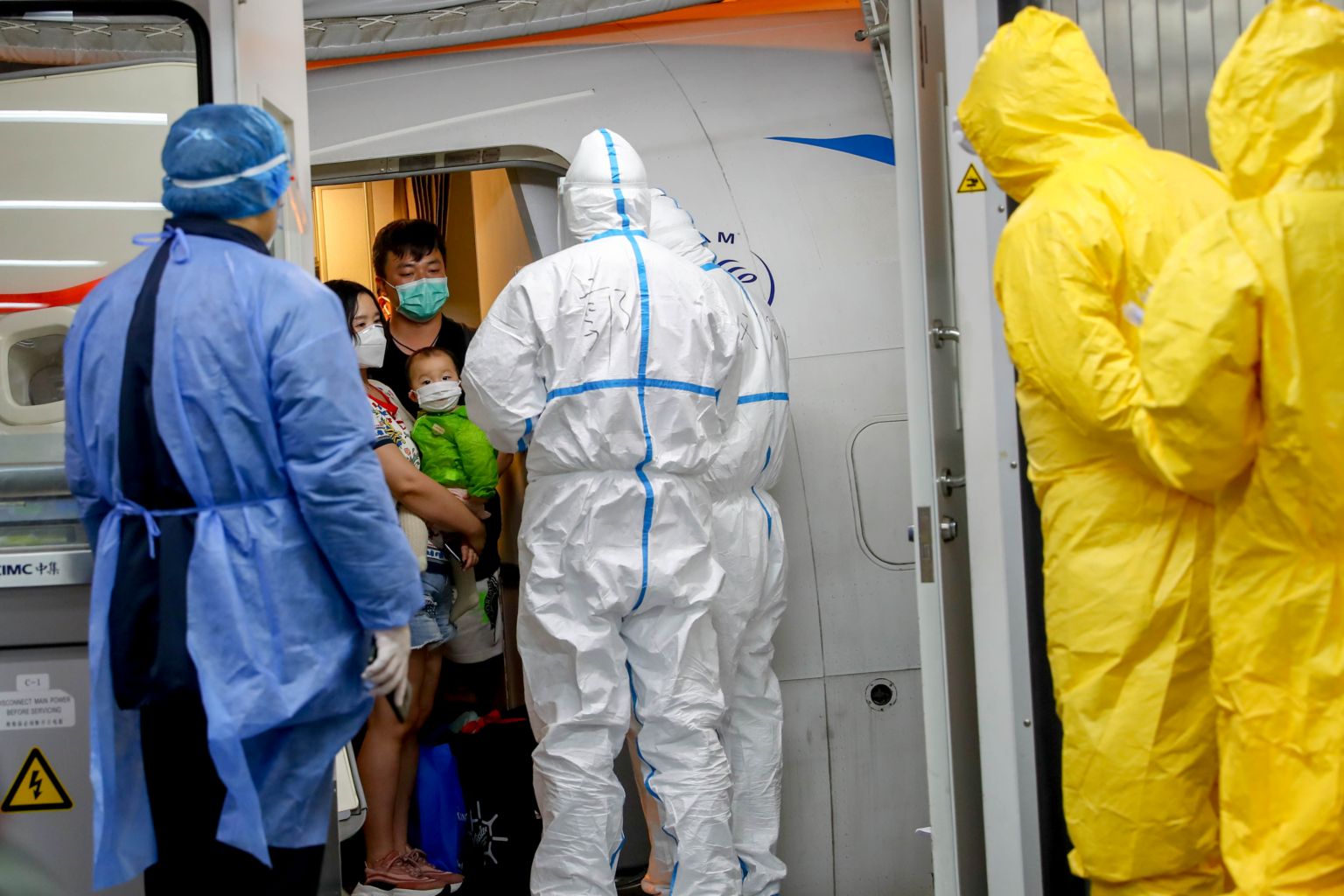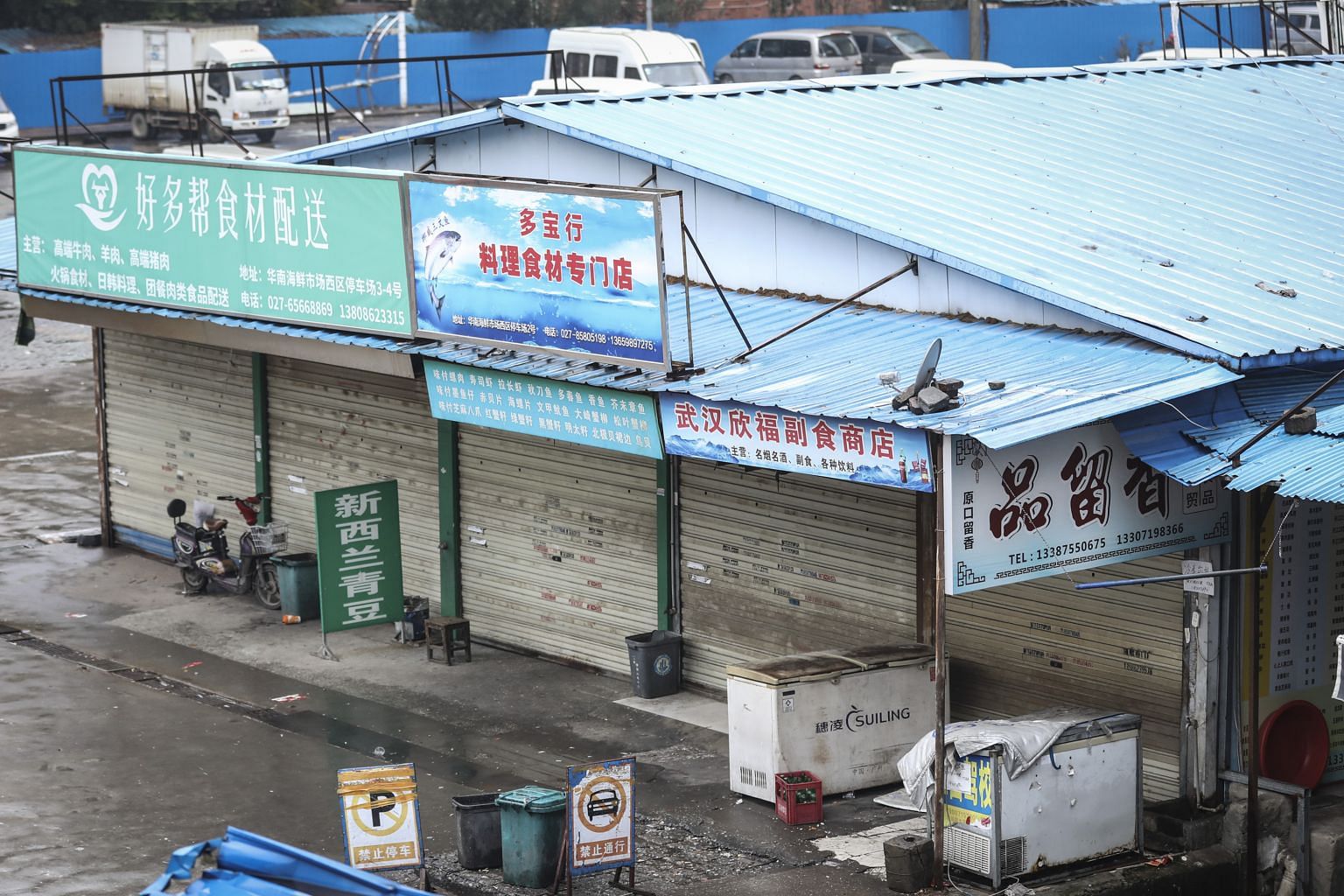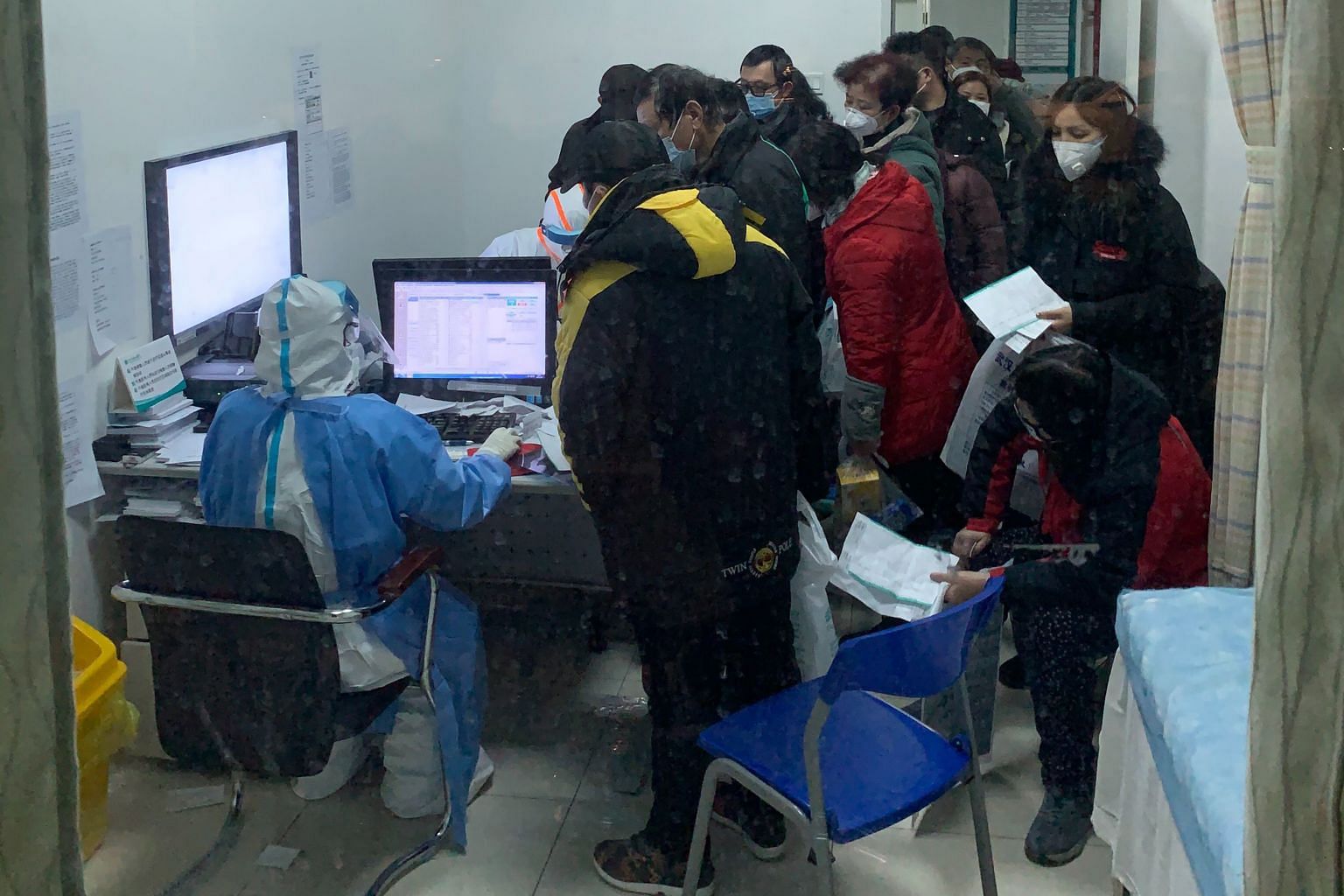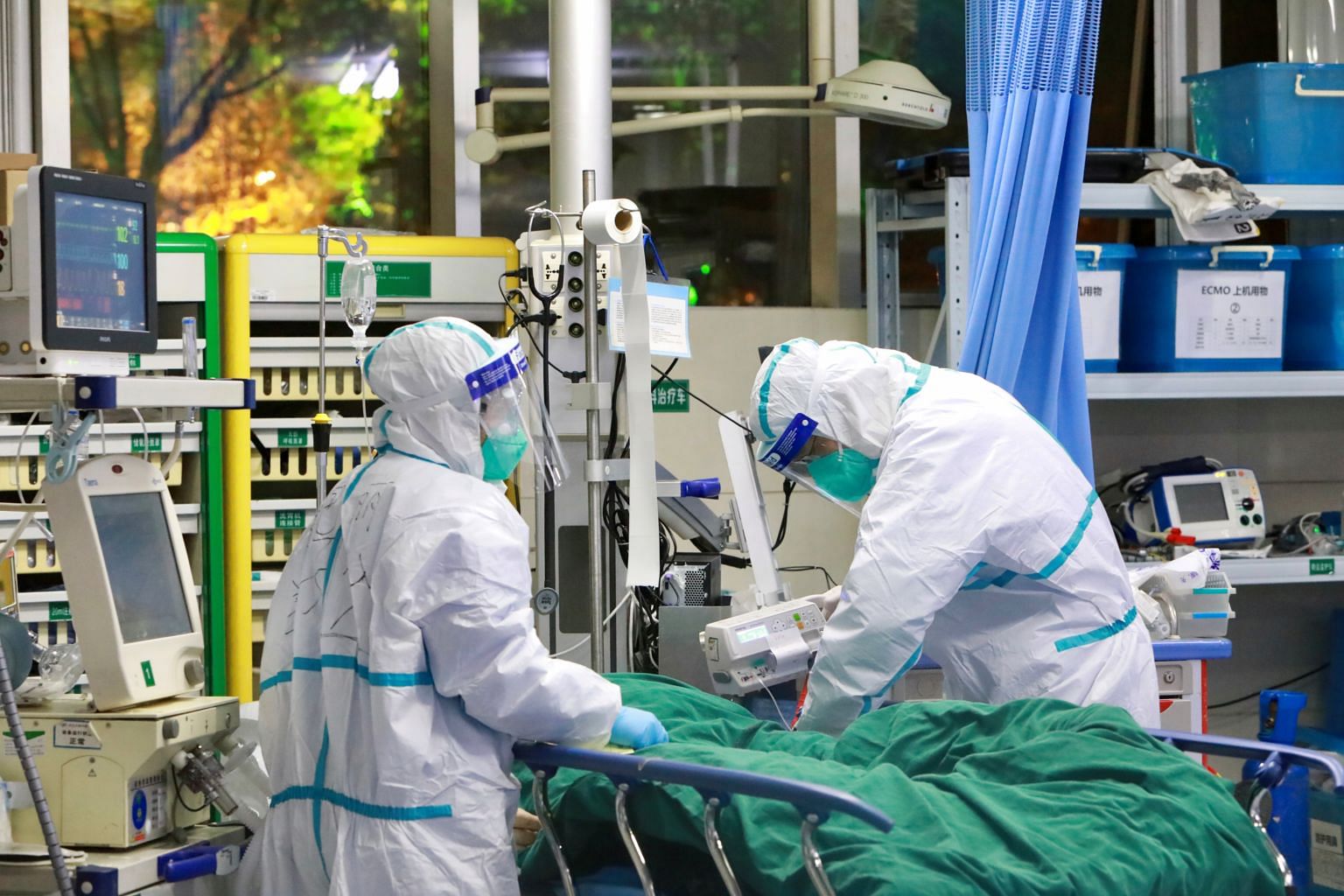How Wuhan lost the fight to contain the coronavirus
Sign up now: Get insights on Asia's fast-moving developments

Workers in protective suits waiting for passengers from a Xiamen Airlines airplane as they get off the charter flight sent by the Chinese government to bring home Hubei residents from Bangkok, on Jan 31, 2020.
PHOTO: REUTERS
Gao Yu, Xiao Hui, Ma Danmeng, Cui Xiankang and Han Wei
Follow topic:
WUHAN (CAIXIN GLOBAL) - Mr Zhang Qi was planning to spend a week of leisure in Wuhan when he arrived on Jan 21. It looked like any other day in the historic, prosperous central China metropolis of 11 million people.
That sense evaporated in the evening as Mr Zhang watched renowned epidemiologist Zhong Nanshan issue a sobering warning in a TV interview. A new form of viral pneumonia was showing signs of spreading among people in the city and had already sickened a number of medical workers, Professor Zhong said.
"I felt something was wrong," Mr Zhang said.
His plans as a tourist abruptly changed early on the morning of Jan 23. News popped up on his phone that the Wuhan government would lock down the city in several hours for disease control, halting all outbound air, rail and bus services. Mr Zhang quickly packed and rushed to the main railway station.
"I am just a tourist," he told Caixin before he boarded a train back home to Beijing. "I don't want to be trapped in this dangerous city."
About 5km away, infectious disease doctor Zhao Lei at the Wuhan Union Hospital was exhausted by the sudden surge of patients over the past month. Since late December, people with fevers and pneumonia-like symptoms had been flooding in, forcing the hospital to expand the fever clinic.
"Shutting down the city was no surprise as it is an effective way to prevent disease from spreading," Dr Zhao said.
But there was no precedent worldwide for putting a city as big as Wuhan under complete quarantine.
Over hundreds of years, Wuhan, the capital of Hubei province, has played a critical role in central China as an economic and transportation hub connecting major parts of the country via an extensive network of road, railway and water routes on the Yangtze River. During the Qing Dynasty, Wuhan was known as the "Thoroughfare to Nine Provinces".
For most of Wuhan's residents, nothing seemed unusual, although word was circulating about a mysterious disease. As the quarantine order fell and more timely information was published, they found themselves at the epicentre of a new pandemic caused by a novel coronavirus, or 2019-nCoV. Although the origin of the deadly virus has not been clearly confirmed, it is believed to have spread from Wuhan to the rest of China and around the world.
Things moved quickly after the quarantine order. Three days after Wuhan cut itself off from the outside, it halted all public transport inside the city. In six days, almost all other cities in Hubei imposed similar lockdowns. By Jan 29, all of the 31 provincial-level regions in the Chinese mainland enacted top-level emergency responses to the virus. More than 6,000 medical workers have been dispatched from across the country to Wuhan.
But the measures have yet to stop the virus from spreading. Casualty numbers continued rocketing over the past week. As of Saturday, 11,821 coronavirus infections were confirmed across China with a death toll of 259. Hubei alone reported 7,153 confirmed cases and 249 deaths, including 192 in Wuhan. The virus has also spread globally as 134 cases have been confirmed in 23 countries, spurring several countries to impose travel bans on China.
On Thursday, the United Nations' World Health Organisation (WHO) declared the coronavirus outbreak a global health emergency while emphasising its confidence in China's capacity to control the outbreak. WHO director-general Tedros Adhanom Ghebreyesus praised China's efforts to contain the outbreak, saying he had never seen a nation respond so aggressively to a disease.
Since the Wuhan lockdown, many major Chinese cities have sought to contain the virus by restricting transit or extending the Chinese New Year holidays. Streets in many cities, including Beijing, were deserted during the normally convivial holiday, as people were encouraged to stay home. Medical experts say they think the coronavirus has an incubation period of as long as 14 days, so strict limits on movement of for at least two weeks from the Wuhan lockdown will be a crucial measure for containing the disease.
Now China is fighting a war against the virus, which has cost the economy heavily and disrupted the lives of ordinary people, especially those in Wuhan. As the country gradually recovers from the shock and fear inspired by the virus, many questioned why the virus crisis spread so quickly in Wuhan and whether there was any chance of a better outcome.
The demon returns
Word circulated online since late December that a mysterious pneumonia was spreading in Wuhan, recalling Chinese people's painful memory of the Sars epidemic in 2003, which claimed nearly 800 lives.
On Dec 30, a document from Wuhan's public health authority went viral on the Internet, confirming that the city's hospitals had received a rising number of patients who showed pneumonia-like symptoms. All the patients had contact with the South China Seafood Wholesale Market in downtown Wuhan, according to the document.
Established in 2003, the 30,000 sq m market accommodates more than 1,000 merchants selling a wide range of farm products and seafood. The market supplies almost all the restaurants in Wuhan and neighboring areas.
"Without the market, the whole catering industry in Wuhan would stop," a vendor told Caixin.
It is widely believed that the market, which is home to a grey market for trade in wild animals, is also where the virus started its journey around the world.
On Dec 31, the Wuhan city government for the first time disclosed that 27 pneumonia cases were confirmed in the city, including seven severe cases and two recoveries. Caixin learnt that on the same day, a group of epidemic prevention workers were sent to the seafood market for disinfection, and a team of public health experts from the National Health Commission arrived at Wuhan to investigate the mysterious disease.
The next morning, a notice posted at the South China Seafood Market ordered it to be closed for "environmental and sanitation rectification." As vendors packed to leave, unease grew among them about a rumored epidemic.
"The seafood market has been known for its dirty environment for years," said a resident living nearby. "There is always the smell of seafood and dead poultry,"
Unknown origin

People familiar with the South China Seafood Market know that it is not only a place to find a rich variety of seafood but also exotic wild animals sold by vendors in deep corners of the market.
There have always been vendors "selling snakes, pheasants, giant salamanders, crocodiles and hares", said a merchant at the market. Most of the wild animal vendors were located at the western part of the market, the merchant said.
Trading certain wild animals, including live ones, is prohibited by Chinese laws and industry regulations. Although market authorities conduct regular inspections and impose heavy fines on violators, sales of wild animals at the market have never been stopped in the past decade, vendors told Caixin.
According to research published on Jan 26 by the Chinese Centre for Disease Control and Prevention (CDC), 33 among 585 environmental samples extracted from the market tested positive for the virus. Of the positive samples, 93.9 per cent came from the western part of the market.
The CDC later reported that the new coronavirus was very likely passed from certain wild animals to humans at the South China Seafood Market and then evolved into human-to-human transmission.
While all eyes are on the seafood market, some experts said the situation may be more complicated. An essay published by The Lancet medical journal said that while wild animals are the most likely source of the virus, there was more than one venue where the virus was passed to humans. The essay, penned by doctors at Wuhan Jinyintan Hospital, found that only 27 of the first 41 patients diagnosed with the coronavirus infection in Wuhan had contact with the South China Seafood Market.
"Now it seems clear that (the) seafood market is not the only origin of the virus," said Dr Cao Bin, one of the essay's authors quoted by ScienceInsider, a publication of the 172-year-old American Association for the Advancement of Science. "But to be honest, we still do not know where the virus came from."
Muted warnings
Doctors on the front lines of epidemic outbreaks always sense the danger ahead.
Dr Zhao Lei at the infectious disease department of the Wuhan Union Hospital said he received the first patient suspected with coronavirus infection in December. The patient's pneumonia symptoms were quite unusual, and a CT scan showed shadows in his lungs, Dr Zhao said. Although CT scan results are not the only reference for coronavirus diagnosis, they are a key indicator.
In the following days, patients with similar symptoms started to flood into the hospital, sometimes reaching 800 or 900 in one day, Dr Zhao said. The hospital had to transfer more doctors and nurses to the fever clinic to treat the influx of patients.
Several doctors raised concerns of a new strain of virus that showed stronger contagion and severity than normal respiratory infections, but they were confused by the healthcare authorities' hesitance to take measures and official statements declaring the disease controllable.
Mr Li Yunhua (a pseudonym), a radiologist at the Hubei Xinhua Hospital in Wuhan, said he first heard of some patients with Sars-like symptoms in his hospital Dec 30. That night, Mr Li received messages from an online chat group of doctor colleagues in several Wuhan hospitals who warned of a new epidemic emerging in the city.
But the next day, Mr Li said he felt a little relieved when the Wuhan health authority issued a public statement saying there were 27 confirmed pneumonia cases with no sign of human-to-human transmission. No medical worker had been infected, according to the statement.
The following day, Wuhan police said eight people were punished for spreading rumours online. The eight were mostly doctors who sent disease warnings in Mr Li's chat group. The punishment muted many doctors, although more of them sensed the danger of the disease, Mr Li said.
The Wuhan government suspended updating the infection numbers between Jan 5 and Jan 10 during a meeting of provincial lawmakers. When briefings resumed Jan 11, the government again said there were no medical worker infections or evidence of human-to-human transmission, while reporting that the number of infections declined to 41.
"All doctors in our hospital knew it was not right as it was so different from what we'd seen," said a doctor at a large public hospital in Wuhan on condition of anonymity.
A radiologist at another public hospital also raised doubts about the official statistics.
"On Jan 15, I found 50 cases (with lung infections shown on CT scan), but the health commission still reported 41, unchanged from Jan 11," he said.
Doctors sickened
Mr Li noticed an infection on Jan 6 in a CT scan of a respiratory doctor in his hospital. The doctor had never been to the South China Seafood Market, Mr Li said. But officials at the hospital ordered doctors to not disclose any information to the public or the media, Mr Li said.
He was shocked by the surge of patients with lung infections. Since Jan 3, "it started at two to three per day and increased to four to five the next day, and then the number doubled every three to four days", Mr Li said. On Jan 18, he read 86 CT scans with lung infections, and after that more than 100 cases every day.
"I've never seen a virus grow so quickly," Mr Li said. "The speed is stunning."

Mr Li's colleague Liang Wudong underwent a CT scan on Jan 16 after showing symptoms of fever.
"The whole lungs were infected," Mr Li said. Mr Liang was transferred to Jinyintan Hospital Jan 18 and died a week later.
It wasn't until Jan 20 when Prof Zhong Nanshan confirmed infections of 14 medical workers on the TV interview that the public became aware of the risk of human-to-human transmission.
The next day, the Wuhan Municipal Health Commission for the first time confirmed that 15 medical workers were infected. But sources close to the matter said the actual number was much higher.
Mr Li told Caixin that as of Jan 29, more than 30 medical workers at his hospital were suspected of being infected.
On Jan 28, China's Supreme Court corrected the Wuhan police's punishment of the eight people who first flagged the danger of the coronavirus outbreak online. In a statement published on its social media account, the top court said: "If the 'rumour' was heard by the public and led some of them to start protection, we would be in a better position of disease control."
A research report jointly published by the CDC and the Hubei Disease Prevention and Control Centre on Jan 29 said evidence showed that the new coronavirus started passing from patients to their close contacts in mid-December.
Struggles in Wuhan
Mr Xie Zuoliang, 69, said he felt muscle pain and had a fever on Jan 18 after he returned from a photography show in downtown Wuhan. A friend with him also had a fever.
The next day, Mr Xie went to Wuhan Xinhua Hospital for a CT scan and it showed infection in his lungs. Doctor told him only designated hospitals could admit patients with fever at that time according to city government's new policy.
Early Jan 20, Mr Xie arrived at the Wuhan Union Hospital in hopes of seeing a doctor but found hundreds of people queuing up ahead of him. He gave up waiting after five hours.
The next morning, Mr Xie rushed to another designated hospital - Wuhan Xinhua Hospital - but was again stopped by the long queue. A busy nurse told him the hospital was full.
On Jan 22, he said his hopes rose after hearing news that the Wuhan government cleared more medical facilities to receive patients suspected of coronavirus infection. He went to the Red Cross Hospital but was shocked by the chaos - desperate patients angrily shouting at doctors, while exhausted medical staff could barely hold themselves up. A young doctor cried out to his supervisor begging for a break.
"I felt both doctors and patients were in despair," Mr Xie said.
He got some prescription medication after seven hours of waiting but was told there was no room for him to be hospitalised. Failing to find a taxi, Mr Xie walked more than an hour back home in the middle of the night.

Xinhua Hospital's Mr Li Yunhua witnessed how his hospital was overwhelmed by a flux of nervous patients in just a couple of days. Since Jan 20, he has stayed in a hotel near the hospital and has not returned home.
The chaos in hospitals was partly caused by the frequent policy changes by city health authorities, causing confusion to patients and institutions, Mr Li said. But more importantly, it reflected how the government and the public were stunned by the fast-spreading virus after the long absence of true information. Mr Li said he feels guilty for not disclosing the truth to the public.
"Doctors and disease prevention officials have known how serious it is, but none dared to speak out," Mr Li said. "We worked days and nights to race with death to save the patients... They should have avoided such pain."
Qin Jianxing, Zhang Shulin, Peng Yanfeng, Di Ning, Yang Rui, Huang Yuxin and Huang Yanhai contributed to this story.
This story was originally published by Caixin Global.

